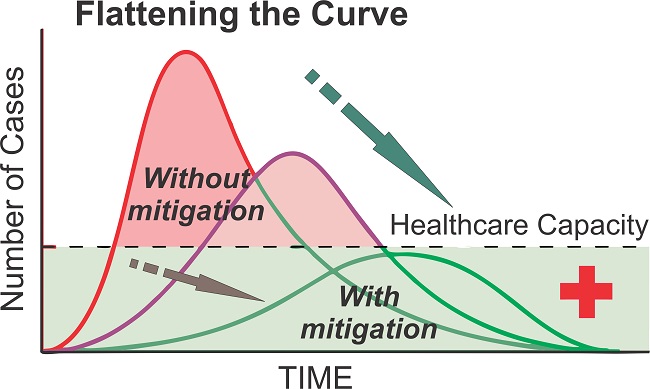
Houston: In these trying times, with the COVID-19 situation changing daily, everyone should be vigilant to thwart the Corona infection and minimize its risk at all levels.
One question making rounds in many people’s minds is whether the country is about to hit the “peak” for cases of COVID-19. That kind of rapid surge tends to start in a few “hotspot” regions because of rapid community transmission and limited mitigation. The peaks are associated with dire consequences to the population, much like the situations in Italy, Spain, USA, China, and other countries.
To avoid these devastating peaks, communities are looking to “flatten the curve” in newly-emerging hot spots. The goal is to keep the number of cases more spread out and consistent over time, so that healthcare systems do not get overwhelmed with too many cases at once. Plus, a flatter curve allows more time to formulate better treatment strategies.
According to top experts, proper mitigation plans can flatten the curve, including:
(1) testing and quarantine; and
(2) social distancing to stop the spread.
Draconian mitigation measures, such as total lockdown of hotspots or even entire regions and strict implementation of health advisory (stay home, good hygiene, etc.), can most effectively stop transmission and help flatten the curve. Public awareness, cooperation, and medical preparation are critical to achieve these goals, as per the scientific advice on Corona curve.
We need to learn from the experience of other hotspots. The metropolitan Wuhan, the original epicenter of the coronavirus crisis in China, was sealed off totally for 76 days to contain the outbreak. While reported numbers are disputed, after implementing these measures, very few new cases were reported afterwards. This is also evident in California's bold efforts with ‘stay home’ which appear to be working to flatten the curve, as compared to New York.
A coordinated effort of the government and public is essential to flattening the curve. This is a paradigm shift for rapid control of the infection, like in South Korea. Strong, competent advice can make all the difference in flattening the curve.
The emphasis on flattening the curve greatly reduces the impending surge, protecting health care providers and facilitating access to critical medical and essential services. A simple way to contribute to this goal is to always wear a mask when outside. Even people without symptoms may still carry the virus and account for a significant amount of transmission, which can be partially protected against by wearing a mask. Keep in mind, however, that a mask alone does not offer complete protection because there are other methods of infection. This is why social distancing and good hygiene are critical for reducing the spread of the virus.
Social distancing, alongside other health practices like washing hands and wearing masks, can actually save live. These practices also help protect the people in our community who are on the front lines of this battle, like security personnel and healthcare workers. As we learned from Italy and USA, the total number of confirmed cases is lower than the total actual cases because of limited testing. Thus, prevention efforts can have exponential effects far beyond that of a single spread. Preventing even one infection can mean avoiding dozens or even hundreds of infections later on; these savings can accumulate and eventually stop the outbreak in its tracks.
So far, the coronavirus has resulted in serious injury in about 15% of cases and death in about 5%, according to the latest reports, making it one of the deadliest viruses in human history. This “mahammari-like” virus cannot thrive without live human cells, so the best way to kill this virus is to stop it from spreading to new cells. If anyone is suspected of symptoms, temporarily quarantine suspects until test results come back. Although emotions like fear and panic are understandable at this time, maintain hope and resilience during this crisis.
Ultimately, if we follow recommendations well, we will make a difference for many. If we stop trying, we will fail. So, for flattening the curve, please stay home and stop the spread.
The author, Dr. Samba Reddy, is a reputed medical scientist in Texas.
Disclaimer: The views expressed are those of the author and do not necessarily represent the views of any organization with which he is affiliated.














